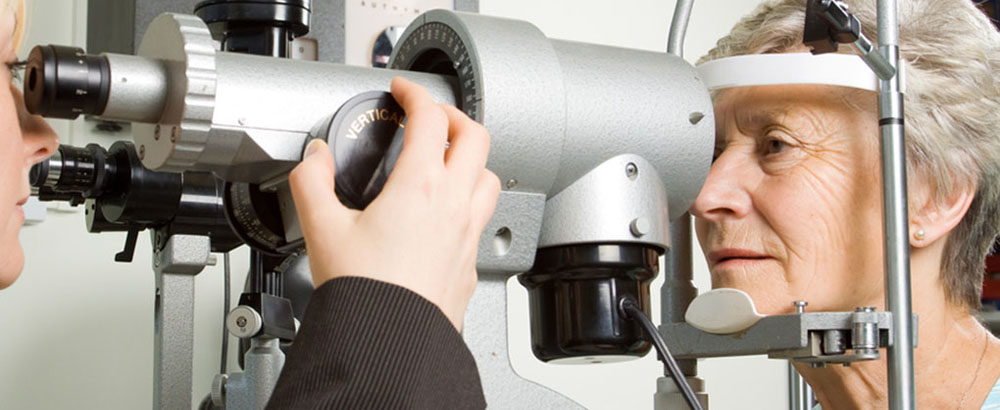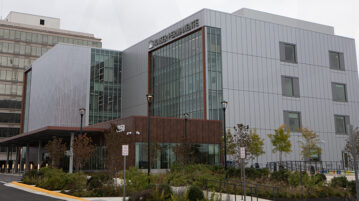By Farhan F. Malik, MD
While presbyopia is easy to correct, it can also serve as a reminder to start having regular appointments to have your eyes checked, since you are at higher risk of developing age-related eye diseases and conditions as you get older. The National Eye Institute recommends that everyone have a comprehensive dilated eye exam with an eye care professional by age 50, even if you are not experiencing any vision problems. (People with high blood pressure should have a baseline exam at age 40 and those with diabetes should have an annual eye screening.)
Many age-related eye conditions have no early warning signs or symptoms, so it’s important to identify and address them in the early stages – before you experience long-term vision loss. Here are a few of the conditions your optometrist or ophthalmologist will check for:
Glaucoma
Known as a silent sight-stealer, glaucoma can develop without any symptoms and lead to irreversible vision loss. It is a leading cause of blindness in the United States, and it usually occurs when the eye does not drain fluid as well as it should, causing damage to the optic nerve.
Some people are at higher risk of developing glaucoma, including African Americans, everyone over age 60, and those with a family history of the condition. If you fall into a high-risk group, it’s particularly important for you to have a dilated eye exam every one to two years.
The most common form of glaucoma is primary open-angle glaucoma. This usually develops gradually, when fluid builds up and starts putting pressure on the optic nerve. If you are diagnosed with this form of glaucoma, there are a variety of treatments that can be used to prevent vision loss, including eye drops, pills, and surgery.
Much rarer is acute glaucoma or narrow angle glaucoma, which occurs when pressure on the optic nerve rises very quickly. Symptoms include headache, eye pain, nausea, rainbows around light at night, and blurred vision. It’s important to see an eye care professional immediately if these symptoms develop. Treatment usually involves laser surgery, which is often successful and long lasting.
Cataracts
Most cataracts, which result in a clouding of the eye lens, are related to aging. By age 80, more than half of all Americans have either had a cataract or have undergone cataract surgery.
Because cataracts tend to develop slowly, you may not notice changes in your vision right away. But over time, you may find your sight getting cloudy or blurry, with colors seeming increasingly faded. Other symptoms include poor night vision and sensitivity to glare. Headlights, lamps, or sunlight might seem too bright, and/or you may see a halo around lights. As a cataract grows larger, you might experience double vision or multiple images in one eye.
Surgery, which involves removing the cloudy lens and replacing it with an artificial lens, is the only effective treatment for cataract. Cataract surgery is one of the most common operations performed in the United States and improves vision in about 90 percent of cases, according to the National Eye Institute. But it’s important not to rush into surgery, since a cataract only needs to be removed when it starts interfering with your everyday activities, such as driving or reading. Discuss the risks and benefits of cataract surgery with your eye care professional to decide if and when cataract surgery is best for you.
Posterior Vitreous Detachment (“Floaters”)
If you’ve ever noticed black specks or “floaters” that seem to jump in and out of your line of vision, you are probably experiencing a common condition known as posterior vitreous detachment (PVD). This occurs when the vitreous gel in your eye separates from the retina (in the back of your eye) as a natural part of aging. By age 65, about two-thirds of people will notice large floaters. If you are near-sighted, these may begin appearing even earlier.
Most of the time, floaters caused by PVD (which can sometimes be accompanied by lightning streaks in your peripheral vision) are merely an annoyance. But in rare cases, a vitreous detachment can pull so hard on the retina that it causes a macular hole or lead to a retinal detachment. Both can lead to permanent vision loss if left untreated. So if you experience a sudden increase in floaters or flashes of light in your peripheral vision, or a “shade” or “curtain” blocking your vision, it is important to see an eye care professional immediately.
Age-Related Macular Degeneration (AMD)
A leading cause of vision loss in people over age 50, AMD causes damage to the macula, a small spot near the center of the retina, which is crucial for allowing sharp, central vision. Sometimes AMD progresses very slowly, while other times it moves quickly, causing vision loss in one or both eyes. The most common symptom of AMD is a blurred area near the center of your vision.
In addition to age being a major risk factor, smoking has been shown to double the risk of AMD. Those with a family history of the condition are also at higher risk, and the condition is more common in Caucasians than in African Americans or Hispanics/Latinos.
Because early and intermediate AMD often develops without symptoms, it is important to have regular dilated eye exams for detection. Your eye care professional will look for the presence of “drusen” – yellow deposits that develop beneath the retina, as well as pigmentary changes in your retina. While there is currently no treatment for early AMD, most people with this condition do not experience vision loss.
You may be able to reduce your risk of AMD, and/or slow its progression, by adopting healthy lifestyle choices: stop smoking, get regular exercise, eat a healthy diet rich in green leafy vegetables, and keep your blood pressure and cholesterol levels in check.
In a relatively small percentage of people (about one in seven), early or intermediate AMD will progress to one of two types of late AMD. Dry AMD causes a gradual breakdown in light-sensitive cells in the macula and tissue that supports the macula, resulting in vision loss. Wet AMD causes abnormal blood vessels to grow beneath the macula, which leak fluid and blood and damage the macula, also causing vision loss. Wet AMD can advance more quickly, and it is possible to have both types of late AMD in a single eye.
Based on studies conducted by the National Eye Institute (known as AREDS and AREDS2), you might benefit from taking a nutritional supplement in order to slow the progression of intermediate to late AMD, specifically one that includes vitamin C, vitamin E, zinc, copper, and either beta carotene or lutein/zeaxanthin. But it is important to consult your doctor or eye care professional about which formulation – if any – is best for you, based on whether or not you smoke and on other factors.
With wet AMD, there are steps you can take to help prevent further vision loss, including regular injections into the eye with a drug that blocks the growth of new, leaky blood vessels. Less common is a treatment called photodynamic therapy (“cold” laser treatment of selected areas of the retina) or “hot” laser surgery (used when the blood vessel growth is limited to a spot that is away from the center of the macula).
While some age-related eye conditions are impossible to prevent or avoid, you can improve your chances of maintaining healthy vision longer by taking some easy steps:
- Always wear UV-blocking sunglasses, which can delay the development of cataracts, prevent retinal damage, and protect against both cancerous and non-cancerous growths in the eye.
- Avoid smoking. Studies show that smokers are at higher risk of developing both AMD and cataracts.
- Eat a variety of vegetables, especially green leafy ones (though patients taking blood thinners should consult their doctor first).
Learn more about cataracts, glaucoma, and other age-related vision problems on MAPMG’s Staying Healthy pages.




